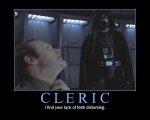Plane Sailing
Astral Admin - Mwahahaha!
The Cleric has always existed in the D&D game as the third Class (preceded by Fighting Man and Magic-User, and slightly earlier than the Thief).
I'm curious as to where you get this impression from.
The original white box set had the fighting man, cleric and magic user. The original three
Supplement 1 (Greyhawk) introduced the thief and the paladin (making them peers)
Supplement 2 (Blackmoor) introduced the monk and the assassin
Supplement 3 (Eldritch Wizardry) introduced the druid
Various issues of the Strategic Review introduced the Ranger and the Illusionist, but I can't be sure of the order there I'm afraid.
Anyway, you should really either talk about the original three or original five
Cheers




